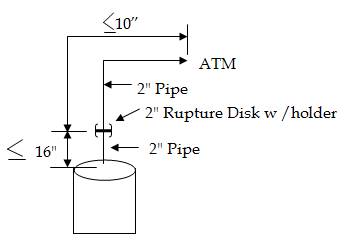Chemical and Process Engineering Resources

Rupture Disks for Process Engineers - Part 2
Nov 08 2010 01:30 PM | pleckner in Safety and Pressure ReliefCoefficient of Discharge Model
The second calculational method is the Coefficient of Discharge Method. The rupture disk is treated as a relief valve with the flow area calculated utilizing relief valve formulas and a fixed coefficient of discharge, ‘Kd', of 0.62. This method does NOT directly take into account piping so there are restrictions in its use. These restrictions are known as the "8 & 5 Rule" which states that in order to use this method to
The rupture disk must be installed within 8 pipe diameters of the vessel or other overpressure source.
- The rupture disk discharge pipe must not exceed 5 pipe diameters.
- The rupture disk must discharge directly to atmosphere.
- The inlet and outlet piping is at least the same nominal pipe size as the rupture disk.
A sketch of the "8 & 5" rule starting with a 2" nominal sized pipe is shown at the below.
The flow area calculated with this method is called the Minimum Net Flow Area or MNFA. The MNFA is the rupture disk's minimum cross
 |
| Figure 1: Diagram Showing the "8 & 5" Rule |
sectional area required to meet the needed flow.
This is not the area (and thus the size) you specify. Just like a pipe with a nominal size and an actual inside diameter, the rupture disk has a nominal size and an actual Net Flow Area or NFA. The rupture disk purchased must have a NFA equal to or greater than the MNFA. The manufacturer publishes the NFA for every rupture disk model and size they sell. The NFA also accounts for bursting characteristics of the disk and the holder.
Below is a list of some Continental Disc Corporation rupture disks with their NFA4.
Â
Rupture Disk (and holder) Type | Nominal Size, inches | NFA, in2 |
ULTRX | 1-1/2" | 2.04 |
ULTRX | 3" | 7.39 |
SANITRX | 1-1/2" | 1.18 |
SANITRX | 3" | 5.49 |
Once the actual NFA of the rupture disk is determined, the calculations must be repeated, basically for the same reasons discussed above for the Resistance to Flow Method.

 FB
FB

0 Comments